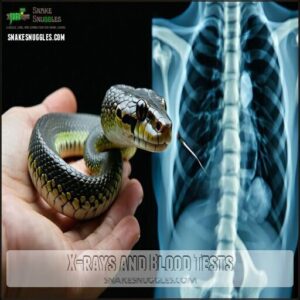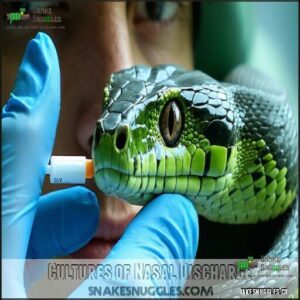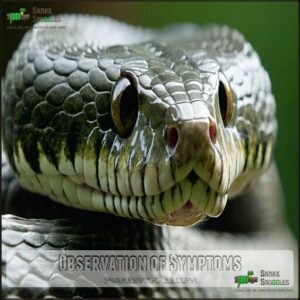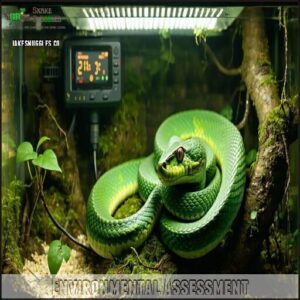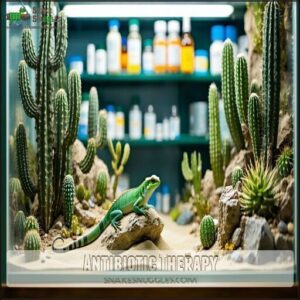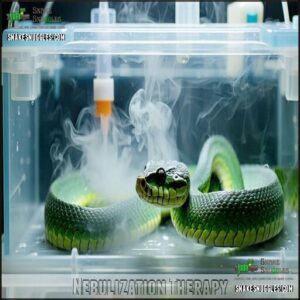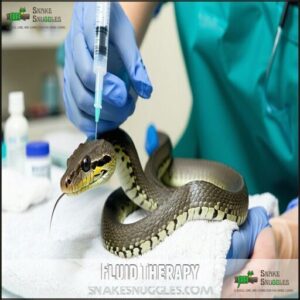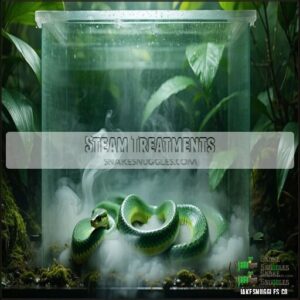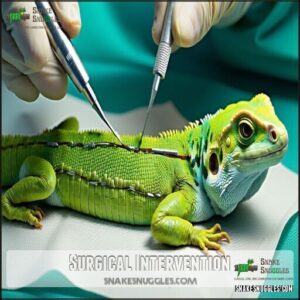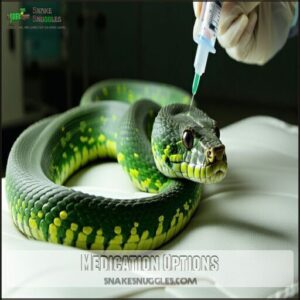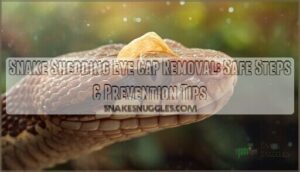This site is supported by our readers. We may earn a commission, at no cost to you, if you purchase through links.
 If your scaly companion is wheezing or bubbling at the mouth, you’ll need to act quickly on snake respiratory infection treatment options.
If your scaly companion is wheezing or bubbling at the mouth, you’ll need to act quickly on snake respiratory infection treatment options.
First, consult a reptile veterinarian who might prescribe antibiotics like ceftazidime or enrofloxacin.
You’ll need to maintain proper humidity (50-70%) and temperature (85-90°F) in your snake’s enclosure.
Nebulization treatments can help loosen mucus, while injectable or oral medications target the underlying infection.
Don’t forget supportive care—ensure hydration and consider syringe-feeding if your snake isn’t eating.
Like humans with a cold, your snake needs extra TLC during recovery.
The right antibiotic combination could make all the difference.
Table Of Contents
- Key Takeaways
- Snake Respiratory Infection
- Diagnostic Methods
- Treatment Options
- Supportive Care
- Medication Options
- Frequently Asked Questions (FAQs)
- How do you treat a respiratory infection in a snake?
- What is the treatment for Respiratory Syncytial Virus in infants?
- Are there medical treatments for respiratory diseases in snakes?
- How does a snake recover from a respiratory infection?
- How do you treat a respiratory infection in a reptile?
- Can Snakes get a respiratory infection?
- How long does recovery typically take?
- Can respiratory infections recur in snakes?
- Are homeopathic remedies effective for snakes?
- When should euthanasia be considered?
- Conclusion
Key Takeaways
- You’ll need to consult a reptile veterinarian for proper diagnosis and treatment, as they’ll likely prescribe antibiotics like azithromycin, ceftazidime, or carbenicillin depending on the specific infection.
- You must maintain proper environmental conditions during treatment, including the right temperature (85-90°F) and humidity levels (50-70%), as poor husbandry is often the underlying cause of respiratory infections.
- You’ll benefit from supportive care techniques such as nebulization therapy to loosen mucus, fluid therapy to combat dehydration, and nutritional support if your snake isn’t eating.
- You should isolate your infected snake to prevent spreading the illness, monitor for improvement over the 2-6 week recovery period, and address any underlying causes to prevent recurrence.
Snake Respiratory Infection
When your snake shows signs of a respiratory infection like wheezing or excess mucus, it’s essential to address the issue promptly to avoid complications.
These infections can be caused by bacteria, fungi, viruses, or even environmental factors, making proper diagnosis and treatment vital.
Causes of Respiratory Infections
A snake respiratory infection can stem from several causes.
Bacterial influence is the most common culprit, while parasite incidence may heighten risks.
Fungal response weakens immunity, opening doors to respiratory infections.
Viral contribution further complicates matters, adding to the mix of challenges.
Bacterial Infections
Most bacterial infections in snakes are caused by common bacteria like Pseudomonas or Aeromonas.
These bacteria thrive in poor environments, making infection prevention imperative.
Diagnosing bacterial virulence often involves Gram staining and cultures.
Antibiotic treatment is customized based on this diagnosis to combat snake bacterial infections while avoiding antibiotic resistance.
Quick response guarantees effective snake respiratory infection treatment and recovery.
Parasitic Infections
Parasitic infections, like lung mites or protozoal infections such as coccidia, can wreak havoc on your snake’s respiratory system.
Deworming snakes with antiparasitic medications, including ivermectin, helps combat stubborn parasites.
Prevention strategies, like maintaining a clean enclosure and avoiding infected prey, are key to preventing the spread of these parasites, and early detection is essential to prevent respiratory distress or worse, making it crucial to act fast.
Fungal Infections
When addressing a reptile fungal infection, environmental factors often play a key role.
Fungal infections in snakes, such as Aspergillus, can weaken their immune response.
Using antifungal drugs like itraconazole or terbinafine helps combat these infections.
Infection prevention includes maintaining proper humidity and temperature.
With early care, including antifungal treatments, you can substantially improve your snake’s recovery and overall health.
Viral Infections
Fungal issues may weaken a snake’s defenses, but viral infections bring their own challenges.
Viral strains can trigger severe respiratory symptoms, and some, like nidovirus, are fatal without a cure.
Here’s how to manage snake viral infections:
- Watch for labored breathing or nasal discharge.
- Implement strict prevention strategies, like isolation.
- Support immunity through care and nutrition.
- Consult for antiviral drugs or treatments.
Diagnostic Methods
When your snake shows signs of a respiratory infection, getting an accurate diagnosis is key to finding the right treatment.
Rapid diagnosis is the cornerstone of effective treatment for snake respiratory infections.
You’ll need methods like X-rays, blood tests, and discharge cultures to pinpoint the cause, while evaluating symptoms and their environment for helpful clues.
X-rays and Blood Tests
Snake diagnostic tests often start with X-rays and blood work.
X-rays reveal lung infections or granulomas, though delicate structures may limit imaging details.
Snake blood work provides insights into inflammation or infections, while blood test interpretation guarantees accuracy.
Anesthesia concerns arise with imaging critically ill snakes, adding complexity. Together, these techniques paint a clearer picture of respiratory issues for effective care, which involves understanding the results of blood work.
Cultures of Nasal Discharge
Collecting cultures of nasal discharge is essential for snake respiratory infection testing.
With proper sample handling, microbial cultures help pinpoint pathogens and guide antibiotic sensitivity. While snake pathogen testing is precise, false negatives can occur if the culture collection isn’t ideal.
Lab results from these snake diagnostic tests provide valuable insights, ensuring targeted treatment and the best chance of recovery.
Improper husbandry can increase the risk of bacterial and fungal growth, which is a critical factor in snake health, and proper handling is key to preventing false negatives, ensuring targeted treatment, and ultimately the best chance of recovery.
Observation of Symptoms
Keep a close eye on snake respiratory infection symptoms, as early detection can save your pet.
Watch for signs like mucus appearance around the nostrils, wheezing sounds, or open-mouth breathing.
Lethargy signs often pair with breathing difficulty, and anorexia indicators signal worsening health.
Identifying these respiratory symptoms promptly helps address snake breathing problems before they escalate.
Stay observant—your snake’s life depends on it.
Environmental Assessment
To rule out environmental triggers for a snake respiratory infection, review your pet’s setup.
Poor conditions can lead to reptile respiratory disease.
- Humidity levels: Maintain proper reptile humidity control; too high traps bacteria.
- Temperature gradients: Verify the enclosure suits your snake husbandry needs.
- Ventilation quality: Poor airflow worsens snake enclosure hygiene, promoting infections.
Healthy setups keep respiratory problems at bay!
Treatment Options
When treating your snake’s respiratory infection, it’s important to choose methods that address the root cause while easing symptoms.
From antibiotics to steam treatments, exploring these options can help your reptile breathe easier and recover faster.
Antibiotic Therapy
Antibiotics play a big role in treating snake respiratory infections.
Vets often choose treatments based on the infection’s severity, adjusting dosages as needed.
Medications like azithromycin or ceftazidime target bacteria effectively.
Watch for side effects like lethargy or reduced appetite.
Here’s a quick guide:
| Antibiotic | Dosage | Route | Frequency |
|---|---|---|---|
| Azithromycin | 10 mg/kg | Oral (PO) | Every 3–7 days |
| Carbenicillin | 200–400 mg/kg/day | Intramuscular | Daily |
| Ceftazidime | 20–40 mg/kg | SC, IM, IV | Every 2–3 days |
| Chloramphenicol | 50 mg/kg | Subcutaneous | Twice daily |
The table provides specific details on antibiotic dosages and administration routes, helping in the treatment of infections in snakes.
Nebulization Therapy
Nebulization therapy offers targeted drug delivery for snake respiratory infection treatment, especially when antibiotics alone aren’t enough.
A nebulizer can help deliver medications directly to the lungs. For those seeking specialized equipment, consider a snake nebulizer purchase.
Here’s how it works:
- Choose Nebulizer Types suited for snakes.
- Use specific drugs like amikacin or saline solutions.
- Adjust Treatment Duration for snake species.
- Watch for Side Effects carefully.
Fluid Therapy
Fluid therapy is essential for snakes battling respiratory infections, especially when dehydration risks are high.
Different administration routes, like oral or injectable fluids, depend on their condition. Carefully select fluid types and perform dosage calculations based on weight.
Monitoring hydration levels guarantees effective snake supportive care and recovery. Skin elasticity tests can help determine the severity of dehydration.
This essential treatment combats dehydration while enhancing their chance of overcoming the infection.
Steam Treatments
Steam treatments can ease snake respiratory symptoms by loosening mucus and improving humidity levels.
Here’s how to do it safely:
- Limit treatment duration to 15–20 minutes.
- Use a gentle, controlled steam source.
- Maintain safe practices to avoid burns or stress.
- Tailor steam benefits for your snake species.
This method can be aided with specialized reptile products.
This simple method enhances snake RI treatment effectively, and can be a valuable tool for improving your snake’s health by providing gentle and controlled steam.
Surgical Intervention
When a snake respiratory infection becomes severe, surgery may be needed. Procedures like ulceration removal, abscess drainage, or foreign body extraction facilitate proper tissue repair.
Post-op care is critical, including hydration and monitoring. Always consult your vet for the best treatment options.
Here’s a quick breakdown:
| Procedure | Purpose | Key Focus |
|---|---|---|
| Ulceration Removal | Clear infected areas | Tissue Repair |
| Abscess Drainage | Remove pus buildup | Infection Control |
| Lung Wash | Diagnose and treat | Respiratory Health |
The table provides a summary of the procedures, including ulceration removal, which is crucial for clearing infected areas and facilitating tissue repair.
Supportive Care
When your snake is battling a respiratory infection, supportive care can make a big difference in their recovery.
Providing the right temperature, nutrition, and supplements helps strengthen their immune system and overall health.
Isolation and Temperature Regulation
When managing a snake respiratory infection, isolate your snake using strict quarantine protocols to prevent spreading illness.
Maintain a proper temperature gradient in the enclosure, with a basking spot at the higher end of their range.
Regulate humidity to avoid shedding issues and help with recovery.
A suitable snake isolation setup is essential for preventing cross-contamination.
Snake quarantine procedures and precise temperature regulation can substantially improve your pet’s healing process.
Nutritional Support
If your snake’s appetite wanes, providing nutritional support is key.
Force feeding might be necessary to meet dietary needs while ensuring hydration. Offer nutrient-rich prey for a balanced diet, and use appetite stimulation techniques like warming meals slightly.
Proper nutrition bolsters immune support, giving your reptile a fighting chance to recover.
Remember, gut-loading insects beforehand can enhance their nutritional value.
Remember, your snake’s next meal could be its strongest medicine!
Vitamin Supplementation
Vitamins A and C play key roles in reptile immune support.
A deficiency in Vitamin A increases respiratory infection risks, so supplementation is essential—injectable forms offer precise dosage guidelines.
Oral options help but require care to avoid overdosing.
Pairing vitamins with a balanced diet and nutrient-rich prey boosts the immune system, helping your snake fight infections effectively.
Probiotic Paste
Probiotic paste can work wonders for your snake’s immune system, especially during recovery.
It strengthens gut health, supporting nutrition in recovery and balancing a stressed immune system.
Follow dosage guidelines carefully—consult your vet for administration methods.
Probiotic benefits vary, so research brand comparisons to find the best fit.
A balanced diet combined with this support boosts reptile immune support effectively.
Medication Options
When your snake faces a respiratory infection, medication can be a game-changer for its recovery.
From trusted antibiotics like azithromycin to solutions designed for specific pathogens, understanding the options guarantees your reptile gets the best care, which is crucial for its recovery.
Azithromycin and Carbenicillin
Azithromycin is a go-to for snake respiratory infection care, with a dosage of 10 mg/kg every few days, tackling Mycoplasma and similar culprits.
Watch out for drug resistance. Carbenicillin, injected (200–400 mg/kg/day), targets Pseudomonas, though side-effects like dehydration mean fluid therapy matters.
Combined therapy boosts effectiveness, making these antibiotics key for reptile antibiotic treatment and successful snake RI treatment.
For aspergillosis, consider Amphotericin B treatment with fluid therapy.
Ceftazidime and Chloramphenicol
Ceftazidime and chloramphenicol represent powerful weapons in your snake’s respiratory infection battle. Ceftazidime, a broad-spectrum antibiotic, works effectively at 20-40 mg/kg every 72 hours via SC, IM, or IV routes.
Chloramphenicol shows 70% susceptibility against common pathogens, administered at 50 mg/kg twice daily for indigo, rat, and king snakes.
Addressing poor husbandry practices is also essential for preventing further infections. You’ll need to maintain your reptile at 30°C during treatment for ideal antibiotic activity.
Metronidazole and Dosage Information
When treating your snake with metronidazole for respiratory infections, proper dosage is critical.
This antibiotic works effectively against anaerobic bacteria at 20-50 mg/kg every 1-2 days.
Key points to remember:
- Dosage varies by species – halve the amount for indigo and kingsnakes due to toxicity concerns
- Administration is typically oral for respiratory cases
- A recent study confirmed 50 mg/kg every 48 hours works well for red rat snakes
Frequently Asked Questions (FAQs)
How do you treat a respiratory infection in a snake?
You’ll need antibiotics, nebulization therapy, and supportive care for your snake’s respiratory infection.
Maintain ideal temperature, isolate the sick reptile, and consider fluid therapy.
Veterinary guidance is essential for proper medication dosing.
What is the treatment for Respiratory Syncytial Virus in infants?
You’ll primarily provide supportive care for your infant with RSV, including oxygen if needed, nasal suctioning, and proper hydration.
There’s no specific antiviral treatment, but focus on easing symptoms while their immune system fights back, which is a key aspect of supportive care.
Are there medical treatments for respiratory diseases in snakes?
Yes, when your slithery friend falls under the weather, you can use several medical treatments.
These include antibiotics, nebulization therapy, fluid therapy, steam treatments, and in severe cases, surgical intervention may be necessary.
How does a snake recover from a respiratory infection?
Your snake’s recovery requires antibiotics, proper temperature regulation, increased humidity, and supportive care. You’ll need to isolate them, maintain ideal habitat conditions, and possibly administer nebulization treatments under veterinary guidance.
How do you treat a respiratory infection in a reptile?
For reptile respiratory infections, you’ll need to consult a veterinarian for antibiotics and possibly nebulization therapy.
Maintain proper temperature and humidity, isolate the animal, and provide nutritional support until symptoms improve.
Can Snakes get a respiratory infection?
Absolutely, your scaly friend can develop respiratory infections due to bacteria, fungi, or viruses.
You’ll notice symptoms like wheezing, bubbling around the mouth, and lethargy.
Proper temperature and humidity are essential for prevention.
How long does recovery typically take?
Recovery typically takes 2-6 weeks, depending on the infection’s severity and your snake’s overall health.
You’ll notice gradual improvement as treatment progresses, with breathing becoming easier and energy levels returning to normal.
Can respiratory infections recur in snakes?
Yes, respiratory infections can recur in snakes if the underlying causes aren’t addressed.
You’ll need to maintain proper humidity, temperature, and hygiene in their habitat to prevent these frustrating relapses from happening again, which involves addressing the underlying causes.
Are homeopathic remedies effective for snakes?
Despite claims across the internet, there’s no scientific evidence supporting homeopathic remedies for snakes.
You’ll want to stick with veterinarian-prescribed treatments like antibiotics or nebulization therapy for your snake’s health issues.
When should euthanasia be considered?
Consider euthanasia when your snake shows severe weight loss, refuses food for extended periods, or displays persistent breathing difficulties despite treatment.
You’ll need to weigh quality of life against potential for recovery, considering the overall well-being of your snake in the decision-making process, focusing on persistent breathing difficulties.
Conclusion
Just as a wilting plant revives with proper care, your snake can overcome respiratory ailments with swift intervention.
Remember, effective snake respiratory infection treatment options combine veterinary expertise, environmental adjustments, and medication.
You’ll need to monitor humidity, maintain ideal temperatures, and administer prescribed antibiotics.
Don’t hesitate to seek professional help—your reptilian friend’s life may depend on it.
With diligence and proper treatment, you’ll soon hear clear breathing instead of concerning wheezes from your scaly companion.
- https://www.merckvetmanual.com/multimedia/table/antimicrobial-drugs-used-in-reptiles
- https://www.cabidigitallibrary.org/doi/pdf/10.5555/20103181635
- https://exoticpetvetblog.wordpress.com/2015/12/30/respiratory-conditions-in-reptiles/
- https://veteriankey.com/reptiles/
- https://www.nature.com/articles/s41598-018-23897-z


